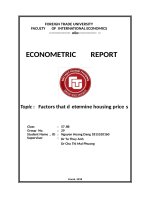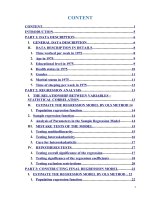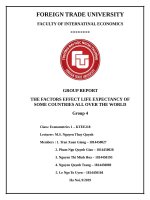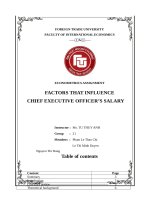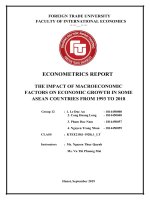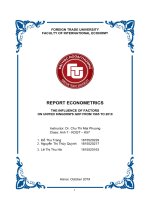tiểu luận kinh tế lượng FACTORS AFFECTING THE INTELLIGENCE QUOTIENT (IQ) INDEX OF FTUS STUDENTS
Bạn đang xem bản rút gọn của tài liệu. Xem và tải ngay bản đầy đủ của tài liệu tại đây (557.27 KB, 31 trang )
FOREIGN TRADE UNIVERSITY
FACULTY OF ECONOMICS & INTERNATIONAL BUSINESS
-----------○○○-----------
ECONOMETRICS REPORT
FACTORS AFFECTING THE INTELLIGENCE QUOTIENT (IQ)
INDEX OF FTU'S STUDENTS
Group:14
Class: KTEE218.1
Lecturers: MSc.Quynh Thuy Nguyen
MSc. Phuong Mai Vu Thi
GROUP MEMBERS
1.
2.
3.
4.
5.
Nguyen Thi Thuy Tram -1814450067
Nguyen Thi Hue - 1816450042
Tran Thi Thuy Dung - 1814450022
Hoang Thu Thuy -1814450066
Karan Singh - 1890190113
Ha Noi, September 2019.
Table of content
Table of content................................................................................................................... 3
ABSTRACT......................................................................................................................... 5
INTRODUCTION............................................................................................................... 6
SECTION 1: OVERVIEW OF THE TOPIC.................................................................... 8
1.1 Intelligence Quotient Index and related terms........................................................ 8
1.2 Theoretical Background............................................................................................ 9
SECTION 2: MODEL SPECIFICATION...................................................................... 11
2.1 Methodology in the study........................................................................................ 11
2.1.1 Method to derive the model.............................................................................. 11
2.1.2 Method to collect and analyze the data........................................................... 11
2.1.2.1 Method to collect the data............................................................................. 11
2.1.2.2. Method to analyze the data.......................................................................... 11
2.2 Theoretical model specification.............................................................................. 11
2.2.1 Specification of the model................................................................................. 11
2.2.1.1 Population Regression Function:.................................................................. 11
2.2.1.2 Sample Regression Function:........................................................................ 13
2.2.2 Explanation of the variables:........................................................................... 13
2.2.3 Description of the data...................................................................................... 14
2.2.3.1 Source of data................................................................................................. 14
2.2.3.2 Statistical descriptions of the variables...................................................... 14
2.2.3.3 Correlation matrix between variables........................................................ 15
SECTION3:ESTIMATED MODEL AND STATISTICAL INFERENCE....................16
3.1 Estimated model...................................................................................................... 16
3.1.1 Estimation result............................................................................................... 16
3.1.2 The sample regression model........................................................................... 16
3.1.3 The coefficient of determination...................................................................... 16
3.1.4 Meanings of estimated coefficients.................................................................. 16
3.1.5 Other results analysis........................................................................................ 17
3,2. Hypothesis Testing.................................................................................................. 17
3.2.1 Verifying the suitability of individual regression coefficient.......................... 17
3.2.2 Verifying the suitability of regression model................................................... 19
3.2.3 Explanation for coefficient that is not statistically significant.......................19
3.3 Some recommendations.......................................................................................... 20
3.3.1 Some recommendations for improving Intelligence Quotient Index.............20
3.3.1.1 Improve GPA.................................................................................................. 20
3.3.1.2 Improve height............................................................................................... 20
3.3.1.3 Others workable solutions........................................................................... 21
a) Learn an instrument........................................................................................ 21
b) Start meditating............................................................................................... 21
3.3.2 Some recommendations for future research................................................... 21
CONCLUSION................................................................................................................. 23
REFERENCES.................................................................................................................. 24
APPENDIX........................................................................................................................ 25
INDIVIDUAL ASSESSMENT......................................................................................... 32
ABSTRACT
“Intelligence is the ability to adapt to change”, said one of the most famous
and beloved scientists of his generation – Stephen Hawking. But what is
“intelligence” exactly? How can it be measured? And most importantly,
what affects this?
These questions are still one of the biggest questions, science is trying to
answer today. But there are already models, which try to explain how the
intelligence of humans could be measured, for example the “Intelligence
Quotient Index” (IQ). But for our group, the last question is more interesting.
What affects the Intelligence Quotient Index?
For this, we decided to identify what are the key factors that influence the
Intelligence Quotient Index of Students from the Foreign Trade University in
Hanoi.
This Report shows the findings from a questionnaire survey, where
empirical studies (n = 90) on factors which may influence the Intelligence
Quotient Index among students are reviewed.
The review details how the Intelligence Quotient Index among students
relates to the gender, the average GPA from the previous year, religion, height.
In this report, multiple ordinary least-squares (OLS) regression was used to
verify the suitability of the model. The model can sufficiently explain the
relationship between the observed and implied variables. The result revealed that
students who have impressive height, achieve high academic achievements and
are not religious often have a higher IQ.
INTRODUCTION
Econometrics is "the quantitative analysis of actual
economic phenomena based on the concurrent development of theory and
observation, related by appropriate methods of inference"( P. A. Samuelson, T.
C. Koopmans, and J. R. N. Stone (1954)- "Report of the Evaluative
Committee for Econometrica," Econometrica 22(2), p. 142.). Econometricians
try to find estimators that have desirable statistical properties including
unbiasedness, efficiency, and consistency.
There are 2 classifications of Econometrics: Theoretical econometrics
(concerning methods and is closely related to mathematical statistics) and
Applied econometrics (assessing economic theories, developing econometric
models, analysing economic history, and forecasting)
Numerous research studies conducted over a period of almost a century
have shown that intelligence is not only essential to an individual’s life but also
an important correlate and determinant of a wide range of economic and social
phenomena including educational attainment, socioeconomic status, earnings
and life achievement. Low intelligence is a significant determinant of
unemployment, poverty, welfare dependency, mortality and crime (Brand and
Smith, 1987)
That’s the reasons why our group opted for the topic “Factors affecting
Intelligence Quotient Index of FTU’s students” to aquire additional
knowledge about some determinants of Intelligence Quotient Index as well as
suggest feasible solutions to improve Intelligence Quotient Index for students.
This essay incorporates the following content:
ABSTRACT
INTRODUCTION
SECTION 1: OVERVIEW OF THE TOPIC
SECTION 2: MODEL SPECIFICATION
SECTION 3: ESTIMATED MODEL AND STATISTICAL
INFERENCES
CONCLUSION
REFERENCES
APPENDIX
INDIVIDUAL ASSESSMENT
During the report-making procedure, we tried to get the best results but
inevitably made mistakes because of lack of knowledge and skills. Therefore,
we sincerely look forward to your comments so that our team can improve.
SECTION 1: OVERVIEW OF THE TOPIC
1.1 Intelligence Quotient Index and related terms
In one sense, human intelligence is something all humans share: it is what
traditionally marks us out from other animals and has made Homo sapiens one
of the more successful species on the planet. It involves language and the
capacity to develop and transmit a culture, to think, reason, test hypotheses, and
understand rules, and so on.
For the greater part of the twentieth century, however, the psychological
study of human intelligence attempted to understand how and why people differ
in intelligence. Until the development of cognitive psychology in the 1960s,
indeed, this focus on individual differences quite overshadowed any attempt to
study the general nature of human intelligence, what people share rather than
what sets them apart. (Mackintosh, 2011)
Intelligence is measured by intelligence tests. These testes typically consist
of several different kinds of tests of verbal reasoning, non-verbal reasoning,
mental arithmetic, vocabulary, verbal comprehension and perceptual, spatial and
memory abilities (Mackintosh, 2011).
The total score derived from these several standardized tests designed to
assess human intelligence is called Intelligence Quotient (IQ) Index
The scores obtained on intelligence tests are expressed in a metric in which
the mean IQ of a representative sample of a national population is set at 100 and
the standard deviation is set at 15. Thus, approximately 96% of the population
have IQs in the range of 70 to 130. The highest IQs that have been recorded are
around 200 (de Jong and Das Smaal, 1995)
1.2 Theoretical Background
Intelligence quotient is determined by several factors which include both
genetic as well as non-genetic factors. Even though genetic factors play the
major role in determining IQ, various other modifiable environmental influences
can influence the IQ of an individual. IQ tests generally are reliable enough that
most people ages ten and older have similar IQ scores throughout life. But some
individuals score very differently when taking the same test at different times or
when taking more than one kind of IQ test at the same age. It has been noted that
25% of assessed individuals will obtain a 10-point IQ score difference with
another IQ battery. Even though not all studies indicate significant discrepancies
between intelligence batteries at the group level the absence of differences at the
individual level cannot be automatically assumed. Variations in IQ scores are
based on an individual’s specific knowledge, vocabulary, expressive language
and memory skills, visual special abilities, fine motor coordination and
perceptual skills. Moreover, one’s emotional anxiety, tension and unfamiliarity
with the testing process can also influence the IQ score (Mackintosh, 2011).
The genetic and environmental factors that determine IQ have been
difficult to pin down scientifically, but several aspects of the environment
including socioeconomic status and education are correlated with IQ, and it has
been shown that malnutrition can reduce IQ. The variability in cognitive abilities
among different individuals is due to the interaction of genetic and
environmental factors. Genetics account for around 50% as per many studies
and increasing with age. Shared and non-shared environment account for 25%
and 20%, respectively, the latter 5% being represented by errors in the
evaluation of the cognitive abilities. Environment can modify genetically
determined cognitive abilities, and an enriched environment can improve the
performance (Aiello and Dean, 1990). Therefore, we want to focus on factors
like gender, religion, previous GPA and height which are all environmental and
genetic factors.
We may be genetically predisposed to a certain brain volume, structure and
pathways – a certain level of intelligence set by our biology – but how much we
achieve isn’t based in biology alone. The type of life we lead also affects
intelligence (Gonzales, Cauce, Friedman, Mason, 1996).
SECTION 2: MODEL SPECIFICATION
2.1 Methodology in the study
2.1.1 Method to derive the model
In our research, we use Multiple Linear Regression, which is a linear
approach to modeling the statistical relationship between a dependent variable
and one or more than one independent variables. In particular, Intelligence
Quotient Index is statistically dependent on Gender, Height, Religion, and
Height.
2.1.2 Method to collect and analyze the data
2.1.2.1 Method to collect the data
We want to measure factors affecting Intelligence Quotient index of FTU’s
students in the previous school year (2018- 2019). 90 people were selected
randomly from that population. We use a cross section of that particular
population range. The data source is taken from our survey
2.1.2.2. Method to analyze the data
In order to analyze the dataset and interpret the correlation matrix between
variables, we use STATA
2.2 Theoretical model specification
2.2.1 Specification of the model
Having considering previous research as well as theoretical background,
our group has built a function to analyze the influences of some factor on
Intelligence Quotient Index:
Intelligence Quotient Index= f(Gender, Height, GPA, Religion)
With a view to determining the effects of these above- mentioned factors on
Intelligence Quotient Index, our group decided to choose the regression analysis
models.
2.2.1.1 Population Regression Function:
Intelligence Quotient Indexi = β0 + β1 Genderi+ β2 Heighti + β3 GPAi + β4
Religioni +µi
In which:
β0 : the intercept term of the model
β1: the regression coefficient of Genderi β2: the regression coefficient
of Heighti
β3: the regression coefficient of GPAi
β4: the regression coefficient of Religioni
µi: the disturbance term of the model, which represents
Intelligence Quotient Index, but these factors are not cited in the model
2.2.1.2 Sample Regression Function:
Intelligence Quotient Index =
+
Gender+
Height+ ̂ GPA +
Religion +
: the estimator of β0
: the estimator of β1
:the estimator of β2
̂
: the estimator of β3
: the estimator of β4
: the estimator of µi- residual
2.2.2 Explanation of the variables:
-
Dependent variable is Intelligence Quotinent (IQ), which is ranged
from 1 to 10 in the questionnaire
1: Normal
5: Intelligent
10: Genius
There are 4 independent variables:
Variable Height (m) from 1 to 10
1m46-1m49: 1
1m50-1m53: 2
1m54-1m57:3
1m58-1m61: 4
1m62-1m65: 5
1m66-1m69: 6
1m70-1m73: 7
1m74-1m77: 8
1m78-1m81: 9
1m82-1m85: 10
Variable religion:
Yes, i have a religion: 0
No, i do not have any religion: 1
Variable GPA: The score is measured in number, it’s positive and the
maximum is 4.0
•
Gender:
Female: 0
Male: 1
2.2.3 Description of the data
2.2.3.1 Source of data
Variables
Source of data
Intelligence quotient
Survey
Gender
Survey
Height
Survey
GPA
Survey
Religion
Survey
2.2.3.2 Statistical descriptions of the variables
After running sum IQIndex Gender GPA Religion Height, we obtained a
resulting table, which tells us the number of observations (Obs), the average
value (Mean), the Standard Deviation (Std. Dev.), the Minimum (Min), the
Maximum (Max) values of each variables
No
Variable
Obs
Mean
1
IDIndex
90 5.633333
2
Std. Dev
Min
Max
1.631502
1
9
Gender
90 0.466667 0.5016826
0
1
3
GPA
90 3.216444 0.4622449
1.5
4
4
Religion
90 0.755556 0.4321649
0
1
5
Height
90 5.066667
1
10
1.97057
2.2.3.3 Correlation matrix between variables
In order to analyze the correlation between the variables, we run
corr IQIndex Gender GPA Religion Height
Then, we have:
IQIndex Gender
GPA
Religion
Height
IQIndex
1.0000
0.1016
0.8621
0.1264
0.3082
Gender
0.1016
1.0000
-0.1197 0.1417
0.6615
GPA
0.8621
-0.1197
1.0000
0.0586
-0.0165
Religion
0.1264
-0.1417
0.0586
1.0000
-0.0334
Height
0.3082
0.6615
-0.0165 -0.0334
1.0000
Gender has a positive but pretty low correlation coefficient of 0.1016.
Therefore, it has a positive effect on the dependent variable IQIndex.
GPA has a positive and extremely high correlation coefficient of 0.8621.
Threfore, it has a positive effect on the dependent variable IQIndex,
Religion has a positive but pretty low correlation coefficient of 0.1016.
Therefore, it has a positive effect on the dependent variable IQIndex.
Height has a medium correlation coefficient of 0.3082. Therefore, it has a
positive effect on the dependent variable IQIndex.
SECTION3:ESTIMATED MODEL AND STATISTICAL INFERENCE
3.1Estimated model
3.1.1 Estimation result
Variables
Coefficient
T
P-value Confidence interval (95%)
Constant
-5.770058
-11.16
0.000
[-0.3532235; 0.3758733]
Gender
0.113249
0.06
0.951
[2.751548;3.338474]
Height
0.267508
5.82
0.000
[0.014334;0.6437907]
GPA
3.045011
20.63
0.000
[0.1761593;0.3588567]
Religion
0.3290625
2.08
0.041
[-6.797711;-4.742406]
3.1.2 . The sample regression model
Intelligence Quotient Indexi =
+
+
Genderi +
Heighti +
GPAi
Religioni +
According to the estimated result from STATA and the Ordinary least
squares (OLS) method, we obtained the sample regression model:
Intelligence Quotient Indexi = -5.770058 +0.113249 Genderi + 0.267508
Heighti + 3.045011 GPAi+ 0.3290625 Religioni +
3.1.3 The coefficient of determination
R2 is 0.8547 means that the estimated model explains 85.47% of the
total variation in the value of Intelligence Quotient Index in this sample.
3.1.4 Meanings of estimated coefficients
̂
= -5.770058 means that if all 4 independent variables equal zero, the expected value of Intelligence
Quotient Index will be -5.770058 . In fact, it does not happen as the minimum of the variable Height is 1 and
GPA of a student never equals 0.
̂
unit of
= 0.0113249 > 0 means that holding other factors fixed, when you are male , the expected Intelligence Quotient Index increases by 0.0113249
measurement.
̂
= 0.267508 > 0 means that holding other factors fixed, when Height increases by 1 unit of measurement, the
expected Intelligence Quotient Index increases by 0.267508 unit of measurement.
̂
= 3.045011 > 0 means that holding other factors fixed, when GPA increases by 1.0 point , the expected
Intelligence Quotient Index increases by 3.045011 unit of measurement.
̂
= 0.3290625 > 0 means that holding other factors fixed, when you don’t have any religion, the expected
Intelligence Quotient Index increases by 0.3290625 unit of measurement.
3.1.5 Other results analysis
Sum squared residual - RSS: 34.4189844: measures the sample variation
in the
The standard error of Gender variable is 0.1833497 which means the
standard distance between the observations and the regression line is about 18%.
Similar with GPA, Religion and Height variable, the distance are about
15%, 4% and 51% respectively
3.2. Hypothesis Testing
3.2.1 Verifying the suitability of individual regression coefficient
Intelligence Quotient Indexi = β0 + β1 Genderi + β2 Heighti + β3 GPAi +
β4 Religioni+ µi
Hypothesis:
(βj = β1, β2, β3, β4)
Testing formula:
Ts=
To verify the suitability of individual regression coefficient we use STATA
and achieve the result as below:
+ P-value of Gender is 0.951 so PGender > α (α = 5%)
At 5% level of significance, we accept the hypothesis
and reject
.
At 5% level of significance, the estimated coefficient
statistically significant.
is not
At 5% level of significance, Gender does not actually affect Intelligence
Quotient index.
+ P-value of Height variable is 0.000 so PHeight < α (α = 5%)
At 5% level of significance, we reject the hypothesis
and accept
.
At 5% level of significance, the estimated coefficient
is statistically
significant
At 5% level of significance, Height does affect Intelligence Quotient
index
+ P-value of GPA is 0.000 so PGPA < α (α = 5%)
At 5% level of significance, we reject the hypothesis
and accept
.
At 5% level of significance, the estimated coefficient is statistically
significant
At 5% level of significance, GPA does affect Intelligence Quotient
index
+ P-value of religion is 0.041, so Preligion <α (α = 5%)
At 5% level of significance, we reject the hypothesis
and accept
.
At 5% level of significance, the estimated coefficient
is statistically
significant
At 5% level of significance, Religion does affect Intelligence Quotient
index
3.2.2 Verifying the suitability of regression model
Hypothesis
(If H0 is rejected, the model is suitable).
Testing formula:
~ F (k – 1, n – k)
To verify the suitability of regression model, we use STATA and achieve a
resulting table which shows that P-value of F statistic is 0.000 < α (α = 5%).
We can conclude that at 5% level of joint significance, we have
enough evidence to reject the hypothesis H0 and accept H1.
In conclusion, the model is consistent at the significance level of 5%.
3.2.3 Explanation for coefficient that is not statistically significant.
According to “Introduction to Psychology” by Plotnik R,
Kouyoumdjian H (2013), numerous researchers support the notion that there are
no significant sex differences in general intelligence, while others have argued
for slightly greater intelligence for males, and others for a female advantage.
These results depend on the methodology, tests which researchers used for their
claims, and the personal performances of the participants. Our outcome is that if
you are male, the expected Intelligence Quotient Index increases by 0.0113249
unit of measurement, which is an extremely minimal rise. So there are no
significant differences between females and males in terms of intelligence. This
belief has been supported by a lot of researchers. Specifically, in 2008 the two
researchers Lynn and Irwing proposed that since working memory ability
correlates highest with Intelligence, researchers would have no choice but to
accept greater male intelligence if differences on working memory tasks are
found. As a result, a neuroimaging study published by Schmidt (2009)
conducted an investigation into this proposal by measuring sex differences on
an n-back working memory task. The results found no sex difference in working
memory capacity, thus supporting those arguing for no sex differences in
intelligence
3.3 Some recommendations
3.3.1 Some recommendations for improving Intelligence
Quotient
Index
3.3.1.1
Improve GPA
Because students’ Intelligence Quotient will increase by about 3.045011
unit of measurement ( the range of Intelligence Quotient is from 1 to 10) if GPA
variable increases by1 point, there is an extremely close relationship between a
person’s GPA in particular (or education attainment in general) and Intelligence
Quotient Index. Although it has been unclear whether this is because education
boosts intelligence or because individuals who start off with higher IQ scores are
likely to get more impressive Intelligence Quotient Index, many studies have
shown that learning can exercise your brain and thus effectively develops greater
cognitive skills. From that, we suggest you should endeavor to obtain high
studying performance( high GPA for example) by reading more books, taking
notes of new knowledge, making a clear studying plan…, which may help to
improve your Intelligence Quotient Index considerably
3.3.1.2
Improve height
Some epidemiological research has proved that after controlling for
socioeconomic class and parental education, there is a small but statistically
significant positive correlation between height and intelligence (as for our
model, height makes the Intelligence Quotient Index increase by about 0.27 unit
of measurement if it increases by 1 unit, ceteris paribus). An individual’s height
is determined by a complex interplay between genes and environment. So it is
an advantage if your parents have a relative height. But if not, we suggest
students should do exercise frequently or subscribe for sport clubs to enhance
the health and get a healthy life to improve your height. Besides, they can absorb
nutrition to increase the average height.
3.3.1.3 Others workable solutions
a) Learn an instrument
Playing an instrument lights your entire brain on intellectual fire and has
lasting impact on math and spatial reasoning skills. It’s not for no reason the
wealthy almost universally require their children to learn a classical instrument
whether they like it or not. Carve out 30 minutes a week to take a lesson and
release your inner rock star.
b) Start meditating
According to numerous studies, beside releasing your stress and refreshing
your mind, meditating is also of great use when it comes to deep cognitive
processing. Therefore, we advise that you should set aside as little as 20 minutes
a day for meditation in order to increase your Intelligence Quotient Index.
3.3.2 Some recommendations for future research
In the light of our research’s shortcomings, we have some suggestions for
future research on Intelligence Quotient Index of FTU’s students .
Since Intelligence Quotient can fluctuate over time, researchers should
conduct Intelligence Quotient research at many different points of time of a
group of students’ university life (for instance, once at the beginning of a year
and once again in the next 2 years), to see how Intelligence Quotient Index
change because many determinants of Intelligence (for example, height) are not
fixed over time.
Moreover, an implication for further research would be to focus specifically
on health and how they affect a student's Intelligence Quotient
Index. Health is important in understanding differences in IQ test scores and
other measures of cognitive ability. Several factors can lead to significant
cognitive impairment, particularly if they occur during pregnancy and childhood
when the brain is growing and the blood–brain barrier is less effective.
In addition, future research should consider performing a large scale survey
of both undergraduate and postgraduate students.
Besides, future studies can also consider testing for the impacts of other
variables such as social-economic status, genes,…on Intelligent Quotient Index.
CONCLUSION
Thanks to knowledge provided by the study and research into (Basic)
Econometrics I and the endeavors of all team members, we have completed our
report quite successfully.
The report –producing process was really helpful because it helps us to
more understand the lectures and especially know how to run STATA. To be
more specific, we gain deeper knowledge of economic methods such as The
Ordinary Least Squares, as well as know how to analyze, test the econometrics
models and the correlation among variables.
From that, our group can draw some conclusions on determinants of
Intelligence Quotient Index of FTU’s students: Religion, Height, and GPA affect
Intelligence Quotient Index of FTU’s students considerably. Meanwhile, Gender
just exerts a minimal effect on Intelligence Quotient Index of FTU’s students
Last but not least, our group would also like to thank the lecturers of the
Economic Faculty MSc. Quynh Thuy Nguyen and MSc Phuong Mai Vu Thi for
having had close instructions and teaching dedication to help us complete this
report.
However, because we still have relatively insufficient knowledge as well as
skills, our report stills contain a lot of mistakes. We hope to get your feedback to
improve the quality of our report and conduct better reports next time.
REFERENCES
Aiello, L. C. and Dean, M. C. (1990). An introduction to human
evolutionary anatomy. London: Academic Press
Benton, D. and Roberts, G. (1988). Effect of vitamin and mineral
supplementation on intelligence of a sample of schoolchildren.
Brand, F. and Smith, G.J. (1987) Effect of the main intelligence quotient of
a modern population on the economy and society.
De Jong, P. F. and Das Smaal, E. A. (1995). Attention and intelligence:
The validity of the Star Counting Test. Journal of Educational Psychology
Gonzales NA, Cauce AM, Friedman RJ, Mason CA (1996). "Family, peer,
and neighborhood influences on academic achievement among adolescents: oneyear prospective effects"
Mackintosh, N.J. (2011) IQ and Human Intelligence, 2nd edition
McCall, P. (1997) Effects of intelligence in childhood and adolescence on
the future earnings of adulthood. Journal of applied socio-psychology.
Bouchard Jr, TJ (1998). "Genetic and environmental influences on
adult intelligence and special mental abilities". Human Biology; an
International Record of Research
Haier, Richard (2016-12-28). The Neuroscience of Intelligence. Cambridge
University Press
APPENDIX
Appendix 1
Appendix 2
Appendix 3

